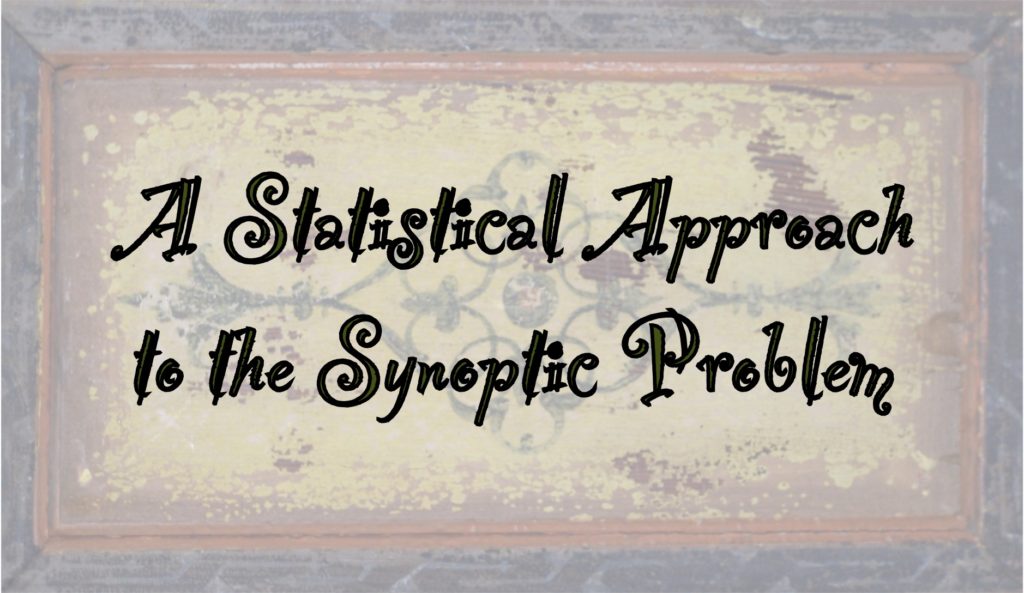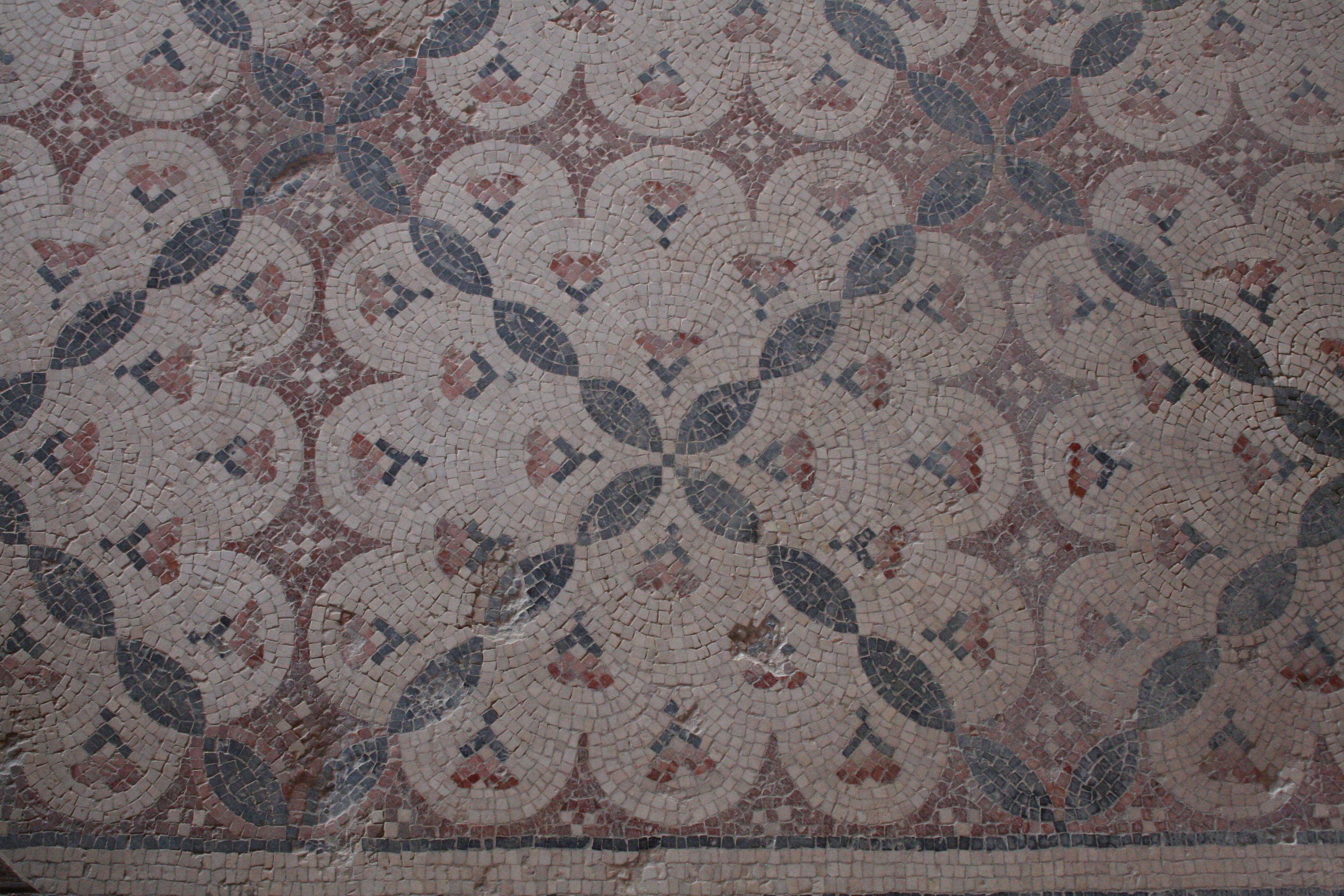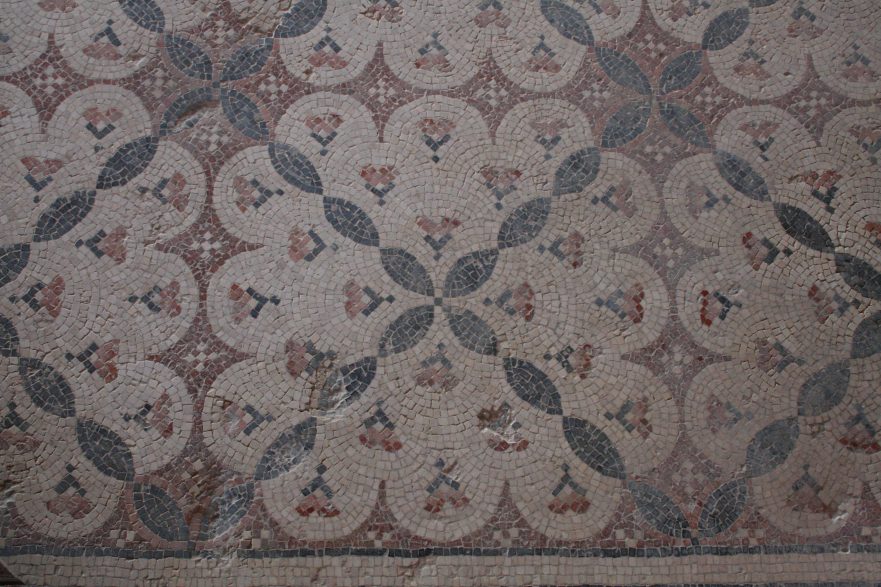
Our approach will involve an attempt to quantify the degree of Semitic influence in the Synoptic Gospels and to compare the level of Semitic influence in the three Single Traditions (Matthean ST, Markan ST, Lukan ST) with the level of Semitic influence in the one Triple Tradition and the three Double Traditions. We will then ask whether the information we have gained from analyzing levels of Semitic influence across the different parts of each Gospel is consistent with or contrary to the Luke→Mark→Matthew scenario of literary dependence.
Premium Members and Friends of JP must be signed in to view this content.
If you are not a Premium Member or Friend, please consider registering. Prices start at $5/month if paid annually, with other options for monthly and quarterly and more: Sign Up For Premium

Mosaic floor in Sepphoris (Zippori) in the Galilee. Photo courtesy of Gary Asperschlager.
- [1] A scenario similar to the one described above may be the best explanation for the "minor agreements" of Matthew and Luke against Mark. In other words, in addition to using Mark, the author of Matthew could have relied on one of the sources used by the author of Luke. ↩
- [2] It is not even necessarily the case that Semitic wording is proof of the chronological priority of the wording. However, in my estimation, when two parallel texts are compared and a much higher level of translation Greek is found in one parallel, much more than in the other parallel, this constitutes a powerful probability that the wording of that text is chronologically prior to the wording of the parallel text which gives a polished Greek version of the same. ↩
- [3] As Kelly comments, “Quantification merely gives precision to the vague words ‘long,’ ‘loose,’ ‘profusion,’ ‘piling up,’ ‘strings,’ and so on.” See Anthony Kelly, A Stylometric Study of the New Testament (Oxford: Clarendon, 1986), 117. ↩
- [4] Using a textual base of 10,000 lines of Greek text, Martin has established seventeen syntactical criteria which enable a researcher to determine whether it a Greek document was originally composed in Greek or whether it was a translation from Hebrew or Aramaic. According to Martin, “It was found that whenever these syntactical features occur with the following frequencies, the Greek is characteristic of translation Greek rather than original Greek:
- dia with genitive 6% -- 1% as frequent as en;
- dia with all cases 18% -- 1% as frequent as en;
- eis 49% -- 1% as frequent as en;
- kata with accusative 18% -- 1% as frequent as en;
- kata with all cases 19% -- 1% as frequent as en;
- peri with all cases 27% -- 1% as frequent as en;
- pros with the dative 2.4% -- 1% as frequent as en;
- hypo with genitive 7% -- 1% as frequent as en;
- kai(coordinating main clause) 2.1 or more for each occurrence of de;
- 5% or fewer articles separated from their substantives;
- 22 or more dependent genitives following the word they qualify for each such genitive preceding the word qualified;
- 9 or fewer lines of Greek text for each dependent genitive personal pronoun;
- 77 or fewer lines of Greek text for each genitive personal pronoun dependent on as anarthrous substantive;
- 35% or fewer attributive adjectives preceding the word qualified for each such adjective following the word qualified;
- 10.1 or more lines of Greek text for each attributive adjective;
- 6 or more lines of Greek text for each adverbial participle;
- 2 or fewer datives not used as the object of en for each occurence of en.”
See Raymond Martin, Syntax Criticism of the Synoptic Gospels (Lewiston, N.Y.: Edwin Mellen, 1987), 9. ↩
- [5] Among Martin’s articles are these:
- Raymond A. Martin, “Some Syntactical Criteria of Translation Greek,” Vetus Testamentum 10.3 (1960): 295-310.
- ——, “Syntactical Evidence of Aramaic Sources in Acts I-XV,” New Testament Studies 11.1 (1964): 38-59.
- ——, “Syntactical Evidence of Semitic Sources in Greek Documents,” Septuagint and Cognate Studies 3 (1974).
- ——, “Syntactical Evidence of a Semitic Vorlage of the Testament of Joseph,” in Studies on the Testament of Joseph (ed. George W. Nickelsburg; Scholars Press, 1976), 105-123.
- ——, “Syntax Criticism of the Testament of Abraham,” in Studies on the Testament of Abraham (ed. George W. Nickelsburg; Scholars Press, 1976), 95-120
- ——, “Syntax Criticism of the LXX Additions to the Book of Esther,” Journal of Biblical Literature 94 (1976): 55-72.
Martin’s books include:
- Raymond A. Martin, Syntactical Evidence of Semitic Sources in Greek Documents (Cambridge, Mass.: SBL, 1974).
- ——, Syntax Criticism of the Synoptic Gospels (Lewiston, N.Y.: Edwin Mellen, 1987).
- ——, Syntax Criticism of Johannine Literature, The Catholic Epistles, and the Four Gospel Passion Accounts (Lewiston, N.Y.: Edwin Mellen, 1989).
- ——, Studies in the Life and Ministry of the Historical Jesus (New York: University Press of America, 1995).
- [6] Altogether Martin has researched some 10,000 lines of Greek text. Martin’s earlier work included all of the books of the LXX, (including also Theodotion’s super literalistic translation), the papyri, Polybius, Herodotus, Thucydides, Xenophon, Diodorus, and Josephus. See Martin, Syntactical Evidence of Semitic Sources in Greek Documents, 6. Later Martin added additional controls from Epictetus, Philo, 2 Maccabees and Hebrews. See Appendix 2 in Martin, Syntax Criticism of the Synoptic Gospels, 137f. ↩
- [7] See the discussion of these issues in Martin, Syntax Criticism of Johannine Literature, The Catholic Epistles, and the Four Gospel Passion Accounts, 1-4, 173-175. ↩
- [8] Martin rejects conjectures about the supposed impact of an author’s Semitic mindset, since he argues that a Semitic mindset would most likely be evident consistently throughout a document. In contrast, empirical observation shows that there are tremendous fluctuations with regard to the degree of Semitic influence within a single document. Such fluctuations are more credibly explained by supposing that the authors of the Synoptic Gospels used sources with varying degrees of Semitic influence, than by supposing that the Semitic influence was imposed on the text by the authors of Matthew, Mark, and Luke. In his first book about the Gospels Martin argues tellingly against both Semitic mindset and artificial “Septuagintalizing” (i.e., the effort to make the Gospels read like the Septuagint since neither of these theories fit the evidence. See Martin, Syntax Criticism of the Synoptic Gospels, 29. ↩
- [9] Martin did do calculations for Matthew and Luke in that he gave the figures for their Triple Tradition (in the Passion narratives, but not in their parallels to Mark 1-10), their Single Tradition, and their shared tradition. Even this was a great help as verification for the observations of Lindsey. ↩
- [10] The data in Chart 1 comes from figures in Martin’s Syntax Criticism of the Synoptic Gospels, 111 (summary of the translation character of Mark 1-10 and the Lukan materials), and 117 (Matthean materials). The figures on Acts are from Syntax Criticism of the Johannine Literature, the Catholic Epistles, and the Gospel Passion Accounts, 7. ↩
- [11] Martin, Syntax Criticism of the Johannine Literature, the Catholic Epistles, and the Gospel Passion Accounts, 45. ↩
- [12] One attempt to explain away Luke’s high levels of Semitic influence is the suggestion that the author of Luke deliberately roughed up the Greek of his source in an attempt to imitate Septuagint Greek, which would supposedly have made his Gospel sound more “biblical” and hence more authoritative. This is how Sparks, for instance, accounted for the Semitisms in Luke. (See H. F. D. Sparks, “The Semitisms in St. Luke’s Gospel” Journal of Theological Studies [old series] 44 [1943]: 129-138.) The “Septuaginalizing” explanation of Luke’s semitisms, however, falters on two grounds. First, I am not aware of any historical precedent that could support this explanation. To my knowledge there are no comparable examples of an ancient author who took a smooth Greek story and roughed it up into translation Greek during the retelling. Until a precedent for such a practice is found in some other ancient Greek source, we should regard this “psychological” explantion with due skepticism. Second, Raymond Martin has effectively demonstrated the radically erratic character of the Semitic influence on the Gospels. Even in Luke one pericope can be highly Semitic in syntax while another pericope within the very same chapter might be very low. If Luke had attempted to artificially impose a “Septuagintalizing” style on his work we would expect him to have done so consistently throughout his entire Gospel. But this is not what we find. There is no evidence of consistent editing in the direction of a “Septuagintalizing style” in any of the Gospels. (See Martin, Syntax Criticism of the Synoptic Gospels, 29; idem, Studies in the Life and Ministry of the Historical Jesus, 2-3.) Since the Semitic influence cannot be explained as artificially imposed by the author of Luke, we must suppose that the Semitic influence the Gospel of Luke does display is due to Luke’s reliance on Semitic-Greek sources independent of Matthew and Mark. ↩
- [13] One could choose to call these materials “Independent Tradition,” since we are referring to material unique to each Gospel which is, therefore, independent from the influence of the other Gospel writers. But “Independent Tradition” too easily suggests the theory that this material is really original material composed by the author of the Gospel in which it appears. However, since it is theoretically possible that all of the writers had at their disposal all of the materials that appear anywhere in the Synoptic Gospels and that each author simply made his own decisions as to what to include and what not to include in his Gospel, I prefer avoid terminology that tends to prejudge the issue. ↩
- [14] Martin does not give the average overall figures for Luke’s TT parallel to Mark 1-10, nor the figures for Matthew’s TT parallel to Mark 1-10. Although Martin did not give the totals for the Lukan and Matthean materials in TT, he did give those provide these figures on a pericope by pericope basis (see Martin, Syntax Criticism of the Synoptic Gospels, 41-46, 75-87.) Following his charts on the individual pericopae, one notes that sometimes one of the Gospel writers is more Semitic, even much more Semitic, and sometimes either of the others is more Semitic. There is no consistent pattern from pericope to pericope throughout any of the three Gospels. It can also happen that any one of the three Gospels can have a very Greek pericope.
What is noticeable is that in Mark 1-10 and its parallels, Mark more often has a pericope that averages out as more Semitic. At first glance this finding seems to contradict Lindsey’s theory of Lukan Priority. Martin himself comments, “Luke and Matthew usually have less Semitic frequencies of the 17 criteria of Syntax Criticism when they have material parallel to the Markan account. Thus Syntax Criticism supports the dominant scholarly consensus that Luke and Matthew used Mark as a source and tend to improve his Greek,” (Martin, Syntax Criticism of the Synoptic Gospels, 37; italics mine). Martin means that Luke and Matthew “usually” have less Semitic features than Mark 1-10 within TT when their individual pericopae are observed. I will discuss this phenomenon in greater detail below. ↩



